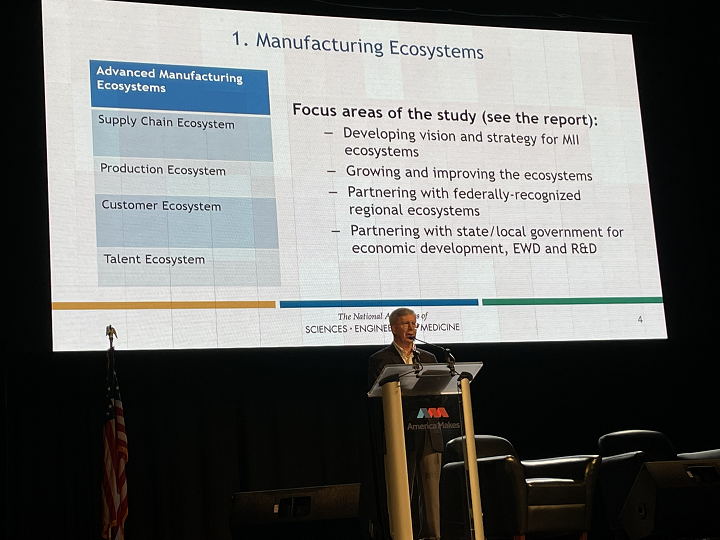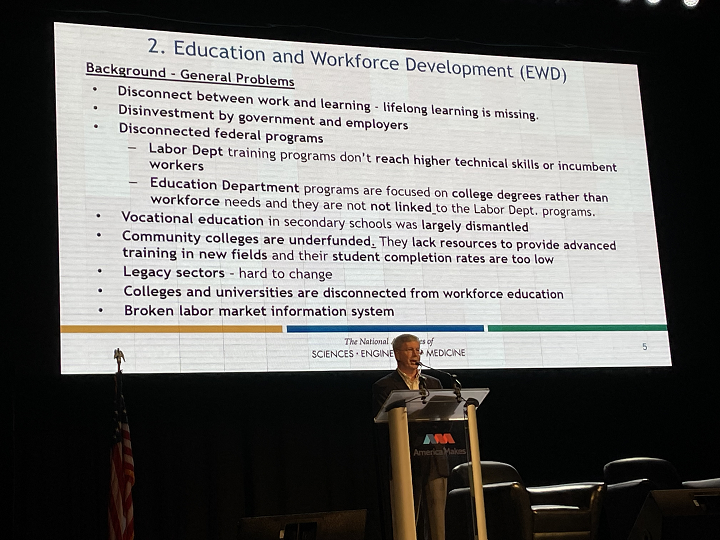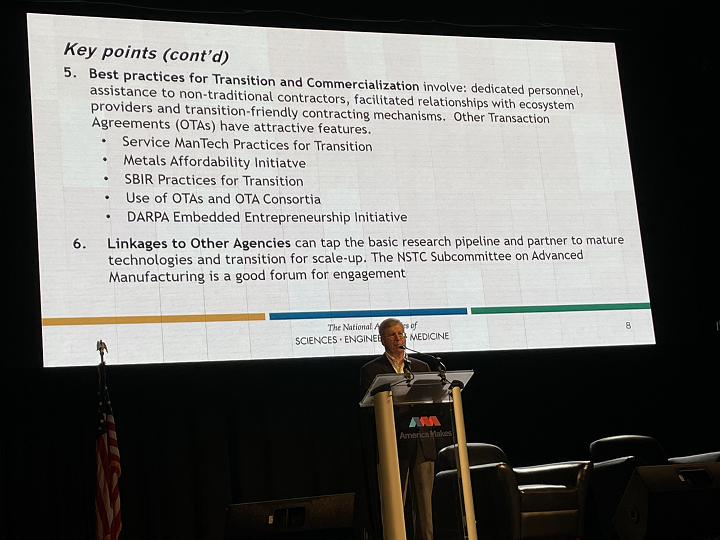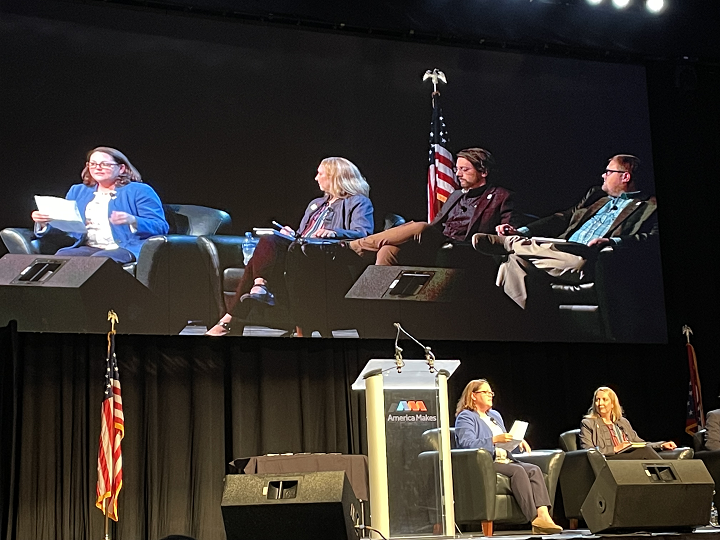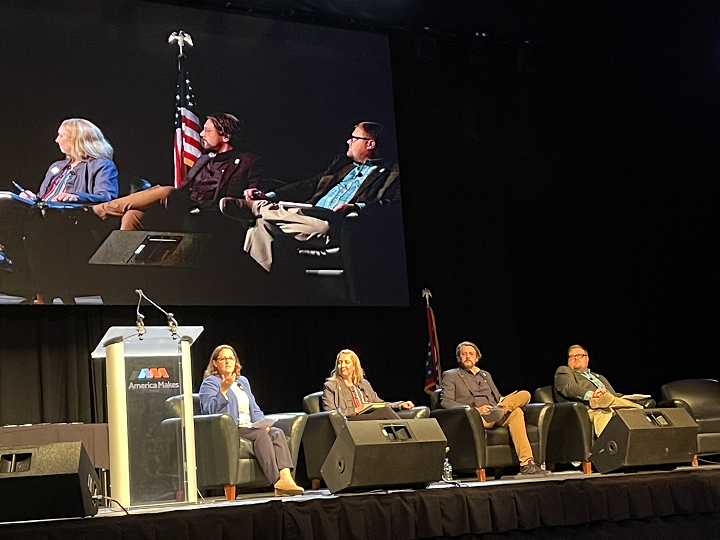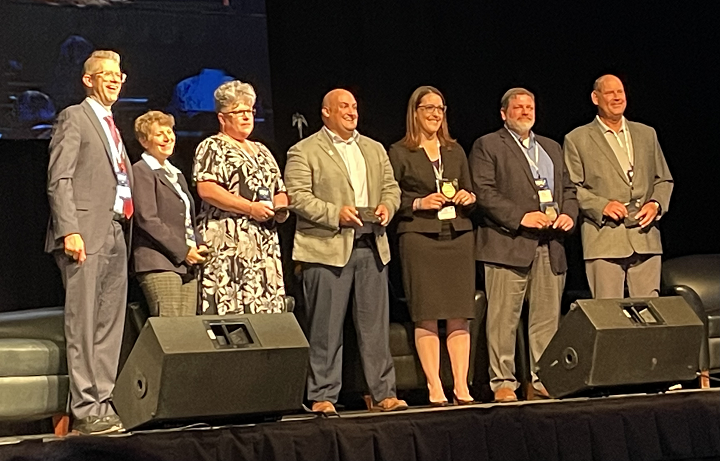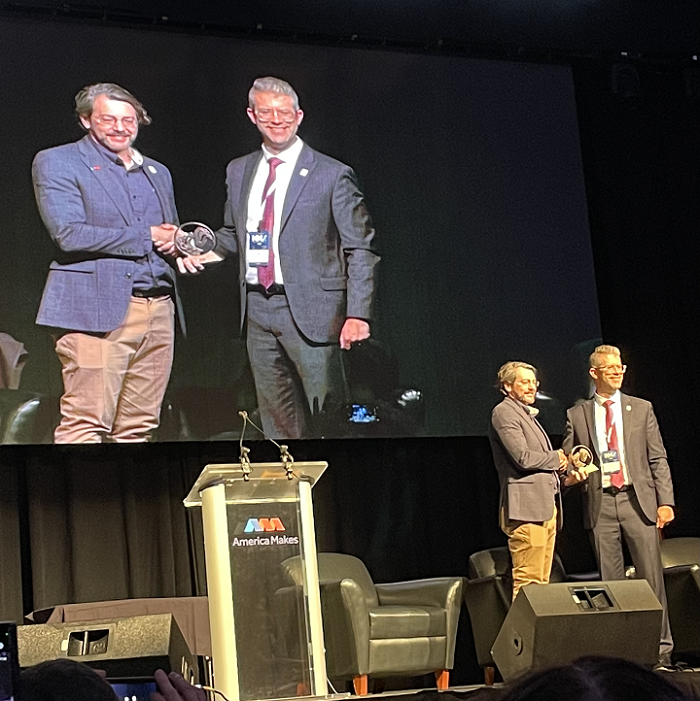America Makes is the United States’ leading public-private partnership for additive manufacturing (AM) technology and education, working to not only accelerate adoption of the technology in the country, but also to increase our manufacturing competitiveness through training, standards publication, projects, and more. The organization, which was the first of the Manufacturing USA Advanced Manufacturing Institutes, opened its doors in Youngstown, Ohio in 2012, and 3DPrint.com was on hand to celebrate its fifth birthday in 2017. So, of course, I made the nearly four-hour drive from my home in Dayton to help celebrate its 10th anniversary at MMX 2022, the Members Meeting and Exchange event for the more than 230 members of America Makes.
As discussed in my previous article, the day continued with an audience-guided panel discussion with the directors of America Makes, as well as a presentation from the National Science Foundation. The next speaker was Michael McGrath, Principal Consultant at McGrath Analytics LLC, who gave a talk titled “The Critical Role of Public Private Partnerships for Manufacturing Innovation.”
Public-Private Partnerships in 3D Printing
McGrath reminded the room of the history of the Manufacturing Innovation Institutes (MIIs), with the President’s council back in 2011 recommending a national network of advanced, public-private manufacturing partnership with a minimum of five years of federal funding. The very next year, America Makes became the first MII, and the Revitalize American Manufacturing (RAMI) act in 2014 formalized the rest of the program.
The DoD and NIST asked the National Academies to study long-term participation by the DoD in the Manufacturing USA Institutes in 2018, and it was determined that the government should continue funding the core institutes, but also add customer-sponsored funding, which should eventually be equal to or greater than the core funding. Two years ago, the DoD asked the National Academies to conduct a Phase 2 study of DoD engagement with its MIIs, which resulted in 27 recommendations that were later endorsed.
After this brief, helpful history, McGrath turned his attention to what he called the three pillars: technology development and transition, education and workforce development, and ecosystem development. The report includes plenty of content about these pillars, which you can see in McGrath’s slides below.
He explained the main focus areas of the study, which include finding best practices and educational models, both regionally and nationally, that are relevant to MII workforce efforts. The program content needs to include training people how, but also why, AM can be used, and to focus more generally on the experience, as opposed to just a single machine.
Another focus area is helping the DoD connect more with the MIIs and its own Organic Industrial Base, which America Makes can help with, and a third is using online education as a “scaling mechanism” for workforce education. The final focus area is credentials and certifications, with plenty of emphasis on “stackable” credentials; this is often seen with IT but less with manufacturing. But embracing it would make the institute more globally competitive.
Strategic 3D Printing Investments
The final panel of the day, “Ten Years of Strategic Investments,” welcomed Tracy Frost, Director of the ManTech Program at the Office of the Secretary of Defense, as moderator, and then three panelists from AFRL: Dr. Jennifer Fielding, Chief, Composites Branch; Dennis Butcher, PhD, Lead, Additive Manufacturing Composites for Limited Life Aircraft Structures; and Adam Hicks, Program Manager.
Frost first asked how it was different to manage an MMI in this public-private partnership.
“Traditional programs have a set of deliverables that are fairly discrete, there’s a very transactional relationship with normal programs,” Hicks said. “In America Makes, the deliverable is to catalyze the U.S. additive manufacturing ecosystem to advance the technology adoption of AM.”
He said he really feels like a part of the team, as they meet regularly to strategize and talk things through, with everyone “marching to that same drum.”
“I think the projects and specific goals definitely look a lot like other contracts or grants we might do, but the mandate is broader, where there’s also this additional focus on making sure that we’re advancing the entire ecosystem, that the nonprofit that’s representing all of you is putting themselves in healthy places of business so they can keep doing that great work for you. That’s very foreign, in some ways, for a lot of other programs we might run,” Butcher said.
Another difference he mentioned was getting to experience some of the benefits of the programs and activities they do because again, the deliverable is a more capable ecosystem.
Dr. Fielding said that AFRL does have a traditional, conventional DoD contract with America Makes, but that usually just one entity is involved, which then benefits from the resulting discovery or transition.
“But, with public-private partnerships and large consortiums, you’re really affecting lots and lots of organizations, not just one, with the tech that’s developed,” she said. “And then you add in workforce development, and that just amplifies the success there for the whole ecosystem.”
She mentioned a few books that she had read about public-private partnerships, and said that one of them listed five tenets to success for these:
- having everyone really involved
- having a shared purpose and sharing resources for this
- high stakes
- relationships that are transparent about the process
- a framework
Dr. Fielding said that the last tenet of a framework or structure was challenging, because on Day 1 of America Makes, “we had nothing.” The framework was essentially built from the ground up. Frost agreed, noting that the original documents detailing the MMIs mentioned “self-sustaining.”
“We looked at it and said, ‘Well, it doesn’t continue to be that partnership if the government just backs out.’ The intention really comes from success, by pulling everyone together and driving towards the common goals that we couldn’t achieve,” Frost continued.
She then asked how America Makes had affected the adoption and translation of AM into the DoD, and Butcher said that the institute is really the “voice of industry,” helping to show the whole picture.
“What you all bring to the table, they can pull that story together and help us understand, so that as we go out and fulfill our needs and requirements, we get the best handle on it that we can.”
Hicks mentioned how helpful the roadmap has been, as well as programs like AMNOW, and that “part of the premise of America Makes is, a lot of times, to treat the government agencies as petulant children, which we can be sometimes, and tell us to sit down, play nice, and get on the same page. I think they’ve been very successful in doing that.”
Dr. Fielding said America Makes has been very impactful on the DoD with the “ample” technology transitions that have happened, but beyond these, the community, standards and roadmap work, and just bringing the community together in such a focused way would not have happened without America Makes.
Frost asked the panelists what’s next, and Hicks said there’s still a lot that’s done well which could be done better, and that the impact to members could be quantified and amplified. Butcher said there’s been a lot of great workforce development already that he would love to see continue for the next wave of innovations, such as construction and composites. Dr. Fielding said they should be doing things with big impact, encourage newcomers to “jump in with both feet,” and that America Makes should never remain static.
America Makes Ambassadors
Finally, Wilczynski came back onstage to announce the the 2022 class of America Makes Ambassadors: individuals who continually demonstrate dedication to advancing the institute and its mission. This year’s Ambassadors are Barb Ewing, YBI; Pamela Szmara, Pamton 3D; Ben DiMarco, OSU; GE Additive’s Brian Thompson and Juan Mario Gomez of Xact Metal, who weren’t there; Joy Gockel, Colorado School of Mines; Jeff Shubrooks, Raytheon, and Congressman Tim Ryan, who was also not there. Additionally, Andrew Snow joined everyone onstage, as he’d been named an Ambassador previously but had never had his round of applause.
Then Wilczynski announced that Butcher, from the previous panel, was being awarded with the Distinguished Collaborator Award for 2022.
All in all, it was a great event, and I enjoyed the opportunity to meet new people, catch up with existing colleagues, and learn a lot in the process. I’m always pleased when my home state of Ohio is in the spotlight for all of the innovation that takes place here, and I, like everyone else at MMX, can’t wait to see what the next ten years bring for America Makes and its partners.
Subscribe to Our Email Newsletter
Stay up-to-date on all the latest news from the 3D printing industry and receive information and offers from third party vendors.
Print Services
Upload your 3D Models and get them printed quickly and efficiently.
You May Also Like
The Market and Industry Potential of Multi-Material 3D and 4D Printing in Additive Electronics
Additive manufacturing leverages computer-based software to create components for products by depositing either dielectric or conductive materials, layer by layer, into different geometric shapes. Since its birth in the 1980s,...
3DPOD 262: Bio-inspired Design for AM with Dhruv Bhate, Arizona State University
Dhruv Bhate is an associate professor at Arizona State University. There, he looks at structures, materials, and design. Previously, he worked at PADT as well as in the semiconductor and...
3DPOD 261: Tooling and Cooling for AM with Jason Murphy, NXC MFG
Jason Murphy´s NXC MFG (Next Chapter Manufacturing) is not a generalist service; instead, the company specializes in making tooling. Using LPBF and binder jet, the company produces some of the...
3DPOD 260: John Hart on VulcanForms, MIT, Desktop Metal and More
John Hart is a Professor at MIT; he´s also the director of the Laboratory for Manufacturing and Productivity as well as the director of the Center for Advanced Production Technologies....



